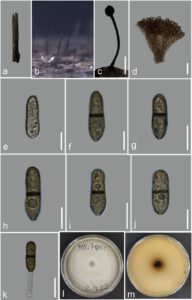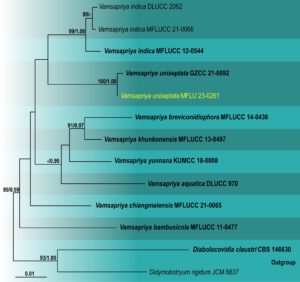Vamsapriya uniseptata N.G. Liu & K.D. Hyde, in Sun et al., Journal of Fungi 7(891), 12 (2021)
Index Fungorum number: IF 558619; Facesoffungi number: FoF 09928; Fig. 1
Saprobic on decaying bamboo. Sexual morph: Undetermined. Asexual morph: Hyphomycetous. Colonies black, effuse. Conidiophores are macronematous, synnematous, erect, rigid, straight or slightly curved, cylindrical, dark brown, septate. Synnemata erect, straight or slightly flexible, dark brown, and comprise compactly positioned conidiophores. Conidiogenous cells monotretic, integrated, terminal, clavate, brown to dark brown. Conidia catenated, acrogenous, oblong, olivaceous brown, rough, guttulate, 1-septate in the middle, subtunicate at the base, and rounded at the apex.
Culture characteristics – Colonies on PDA reaching 90 mm diam. after 14 days at 25 ºC, white in the surface, pale brown in reverse and dark to dark brown in the center, circular, flat, cottony, entire margin.
Material examined – Thailand, Chiang Rai Province, Mae Fah Luang University, dead bamboo, 10 July 2022, Hsan Win, MFLU 23-0261, living culture MFLUCC 23-0265.
GenBank accession number – ITS: OR259106, LSU: OR259087, β-tubulin: OR269618.
Known distribution (based on molecular data) – China (Sun et al. 2021), Thailand (this study).
Known hosts (based on molecular data) – Decaying wood (Sun et al. 2021) and bamboo (this study).
Notes – Vamsapriya uniseptata is distinguished by having 1-septate conidia, while other Vamsapriya species have multi-septate conidia (Sun et al. 2021). According to the BLAST results, the ITS and LSU sequences of our isolate showed 100% similarity to the ITS and LSU sequences of the ex-type of V. uniseptata (GZAAS 21-0378). In the multi-gene phylogenetic analyses, our isolate clustered with the ex-type of V. uniseptata (GZAAS 21-0378) with 100% maximum likelihood bootstrap support and 1.00 Bayesian posterior probability (Fig. 81). Based on similar morphology (Sun et al. 2021) and multi-gene phylogeny, we introduce our isolate as Vamsapriya uniseptata, a new geographical record for Thailand.

Fig. 1 – Vamsapriya uniseptata (MFLUCC 23-0265, a new geographical record). a Dead bamboo specimen. b Fungal structures on the host substrate. c Conidiophores. d Conidiogenous cells and conidia. e–j Conidia. k Germinating conidium. l, m Front (l) and reverse (m) views of the colony on the PDA. Scale bars: c = 200 µm, d, e–k = 10 µm.

Figure 2 — Phylogram generated from maximum likelihood analysis based on the combined LSU, rpb2, β-tubulin and ITS sequence data for Vamsapriya. Thirteen strains are included in the combined analyses, which comprised 2634 characters after alignment (including gaps). Tree topology derived from the Bayesian analysis was similar to that derived from the maximum likelihood analysis. The best RaxML tree with a final likelihood value of -5802.949387 is presented. The matrix had 312 distinct alignment patterns with 33.30% of undetermined characters or gaps. The evolutionary model GTRGAMMA is applied to all genes. Bootstrap values of maximum likelihood analysis greater than or equal to 80% and Baysian posterior probabilities greater than or equal to 0.95 are given near the nodes. The tree is rooted with Didymobotryum rigidum (JCM 8837) and Diabolocovidia claustra (CBS 146630). Ex-type strains are in black bold. The newly generated sequences are indicated in yellow.
